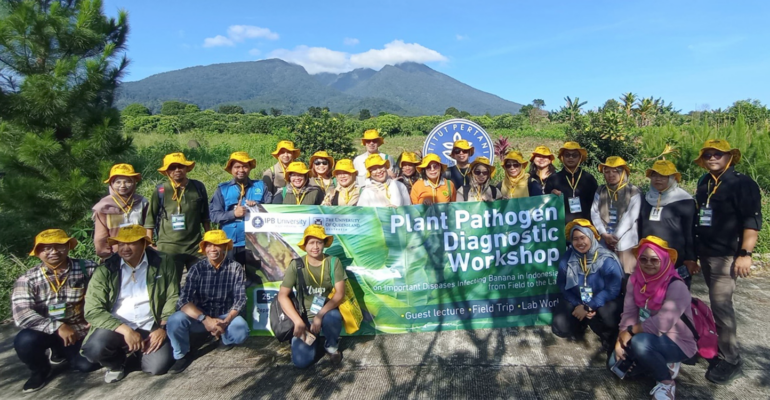Collaborating with the University of Queensland, IPB University’s PTN Department Hosts Banana Disease Diagnosis Workshop

The Plant Protection Department (PTN) of IPB University’s Faculty of Agriculture (Faperta), in collaboration with the University of Queensland, Australia, organized a workshop themed ‘Plant Pathogen Diagnostic Workshop on Important Diseases Infecting Banana in Indonesia: from the Field to the Lab.’
This event was held from June 25th to 28th, involving the Tropical Horticulture Study Center (PKHT) of IPB University and PT Genetika Science as activity partners.
Dr Sari Nurulita, a lecturer from the Plant Protection Department of IPB University, explained that the workshop comprised three activities: Guest Lecture, Field Trip, and Laboratory Work. Participants came from 12 universities in Indonesia, as well as the National Research and Innovation Agency (BRIN), Indonesian Quarantine Agency, and PT Great Giant Pineapple-Lampung.
During the Guest Lecture, Prof Awang Maharijaya, Chairman of PKHT IPB University, discussed the diversity of banana varieties in Indonesia, along with their potential and challenges. “Globally, Indonesia ranks third in banana production, following India and China,” he revealed.
Banana cultivation in Indonesia is primarily carried out by small-scale farmers growing local varieties such as Ambon, Barangan, Kepok, and Tanduk. However, in recent years, banana plantations have started to expand, predominantly cultivating the Cavendish variety.
“Therefore, efforts to conserve local banana varieties are crucial for maintaining biodiversity and supporting food security,” he stated.
Prof Awang also outlined several major challenges in banana cultivation in Indonesia, including pest and disease disruptions, cultivation techniques not yet leveraging technological advancements, and suboptimal marketing and government policies.
Dr John Thomas, a plant virologist from the University of Queensland, has long researched the Banana bunchy top virus (BBTV). In his presentation, he detailed the disruptions and damages caused by BBTV infections.
“Banana bunchy top disease caused by BBTV spreads very rapidly and has been reported to cause significant losses in the banana industry in Australia. Moreover, such outbreaks also threaten food supply in several African countries,” he noted.
To counter this, Dr Thomas recommended controlling banana bunchy top disease through stringent regulations and public education programs.
Some effective regulations include registering plantations before banana planting, establishing quarantine zones, restricting the movement of plant propagation materials, conducting regular plant health inspections, and destroying infected plants.
Another speaker from the University of Queensland, Dr Lilia Carvalhais, is a plant pathologist with research experience in banana diseases, particularly banana blood disease and Fusarium wilt. In her presentation, she thoroughly discussed the pathogens causing these diseases, namely Ralstonia syzygii subsp. celebesensis and Fusarium oxysporum f. sp. cubense.
The field trip was conducted at the Sukamantri Experimental Garden, Faperta IPB University, located in Sukamantri Village, Taman Sari District, Bogor Regency. According to Dr Sari Nurulita, this activity aimed to identify infection symptoms and damage to bananas caused by bunchy top, blood disease, and Fusarium wilt. “In addition, there was an explanation about the technique of collecting diseased plant samples for disease diagnosis in the laboratory,” said Dr Sari Nurulita, a virology expert from IPB University’s Plant Protection Department.
Disease diagnosis began with field observations, followed by analysis at the PTN Department Education Laboratory, Faperta IPB University. Participants performed bacterial, fungal, and fungal detection techniques on plant materials using the polymerase chain reaction method. “Laboratory detection is very necessary and important to confirm disease symptoms observed in the field. Detection techniques must be specific and accurate but not too difficult to perform,” she added. (*/Rz) (IAAS/RUM)



